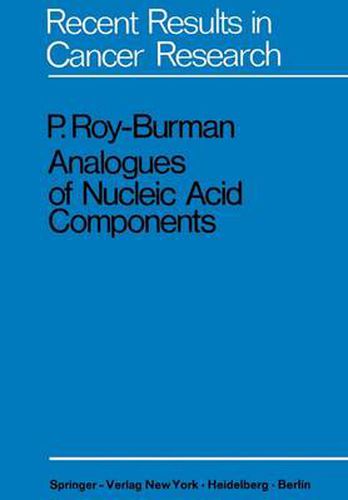Readings Newsletter
Become a Readings Member to make your shopping experience even easier.
Sign in or sign up for free!
You’re not far away from qualifying for FREE standard shipping within Australia
You’ve qualified for FREE standard shipping within Australia
The cart is loading…






This title is printed to order. This book may have been self-published. If so, we cannot guarantee the quality of the content. In the main most books will have gone through the editing process however some may not. We therefore suggest that you be aware of this before ordering this book. If in doubt check either the author or publisher’s details as we are unable to accept any returns unless they are faulty. Please contact us if you have any questions.
The rationale for the design of structural analogues of a normal metabolite is that such compounds may interfere in the utilization or function of the metabolite. A compound which is effective in this respect may be called an antimetabolite. To be successful in chemotherapy of bacterial, viral, or tumor growth, an antimetabolite should adversely affect some vital metabolic reactions in the parasite or parasitic tissue without seriously endangering the host tissue. If a metabolic process of the offending growth is different from that of the host, it is likely that the metabolism or activity of a compound, structurally related to a metabolite involved in that process, will also be different in these cells. Such differences are useful for devising effective drugs with selective actions. Sulfanilamide, a structural analogue of para aminobenzoic acid, interferes with the utilization of this metabolite in the synthesis of folic acid, an essential factor for growth. Bacteria synthesize their own folic acid and are incapable of utilizing exogenously available folic acid. However, the situation is exactly opposite in the animal host. That is, animal tissues cannot synthesize folic acid and are absolutely dependent upon exogenous sources. These differences in metabolism make possible the use of sulfanilamide as a selective inhibitor of growth. Other antibacterial or antiparasitic drugs, such as penicillin (BURCHALL, FERONE and HITCHINGS, 1965) and inhibitors of dihydrofolate reductase (HITCHINGS and BURCHALL, 1965; HITCHINGS, 1964; BURCHALL and HITCHINGS, 1965) have analogous desirable selective toxicity effects.
$9.00 standard shipping within Australia
FREE standard shipping within Australia for orders over $100.00
Express & International shipping calculated at checkout
This title is printed to order. This book may have been self-published. If so, we cannot guarantee the quality of the content. In the main most books will have gone through the editing process however some may not. We therefore suggest that you be aware of this before ordering this book. If in doubt check either the author or publisher’s details as we are unable to accept any returns unless they are faulty. Please contact us if you have any questions.
The rationale for the design of structural analogues of a normal metabolite is that such compounds may interfere in the utilization or function of the metabolite. A compound which is effective in this respect may be called an antimetabolite. To be successful in chemotherapy of bacterial, viral, or tumor growth, an antimetabolite should adversely affect some vital metabolic reactions in the parasite or parasitic tissue without seriously endangering the host tissue. If a metabolic process of the offending growth is different from that of the host, it is likely that the metabolism or activity of a compound, structurally related to a metabolite involved in that process, will also be different in these cells. Such differences are useful for devising effective drugs with selective actions. Sulfanilamide, a structural analogue of para aminobenzoic acid, interferes with the utilization of this metabolite in the synthesis of folic acid, an essential factor for growth. Bacteria synthesize their own folic acid and are incapable of utilizing exogenously available folic acid. However, the situation is exactly opposite in the animal host. That is, animal tissues cannot synthesize folic acid and are absolutely dependent upon exogenous sources. These differences in metabolism make possible the use of sulfanilamide as a selective inhibitor of growth. Other antibacterial or antiparasitic drugs, such as penicillin (BURCHALL, FERONE and HITCHINGS, 1965) and inhibitors of dihydrofolate reductase (HITCHINGS and BURCHALL, 1965; HITCHINGS, 1964; BURCHALL and HITCHINGS, 1965) have analogous desirable selective toxicity effects.